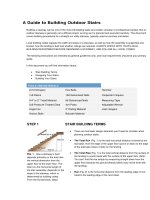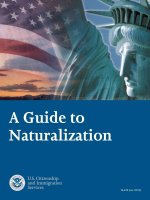Compliance 101: A Guide to Building Effective Compliance Programs
Bạn đang xem bản rút gọn của tài liệu. Xem và tải ngay bản đầy đủ của tài liệu tại đây (643.21 KB, 71 trang )
Compliance 101: A Guide to Building
Effective Compliance Programs
Lori A. Brown, Seton Hall University
Nikita Williams, TCS Education System
Christopher Myers, Holland & Knight
Program Speakers
Lori A. Brown, Esq.
Director of Compliance & Risk Management
Seton Hall University
South Orange, NJ
Nikita Williams, Esq.
Director of Regulatory Affairs & Compliance
Office of Compliance and Legal Affairs
TCS Education System
Moderator
Christopher Myers, Esq.
Partner, Holland & Knight
Chair, Compliance Services Team
Overview
I. Compliance Background
II. Elements of an Effective
Compliance Program
– Session will cover FSG compliance program elements
– Suggestions for small institutions and those with limited
resources
I. Tool Kit
– Handout CD ROM with practical compliance tools
I. Reference Materials
– Will provide citations to additional sources of assistance
I.
Compliance
Background
What is Compliance?
Compliance is a comprehensive program
that helps institutions and their
employees conduct operations and
activities ethically; with the highest level
of integrity, and in compliance with legal
and regulatory requirements.
Why Have Organizational
Compliance and ERM programs?
• Compliance Programs
– Fiduciary Responsibility
– Federal Financial Reporting and Internal
Control Standards
– Legal and Regulatory requirements and
organizational policies
• Enterprise Risk Management Programs
– Standard & Poor’s- Credit Ratings
Business Reasons For
Developing Compliance Programs
• Foster a culture of ethics and compliance
that is central to all of the institution’s
operations and activities.
• Understand the nature of risks and potential
exposures.
• Identify and manage risks that impact the
institution’s reputation.
• Integrate the compliance program into ERM
Framework
Why Are Compliance Programs Important?
BOARD OF
TRUSTEES/REGENTS
Seeking enhanced visibility
into the risks of the
institution
Promoting greater accountability
for risk management
ACCREDITORS &
AUDITORS
HIGHER ED
ANALYSTS
INSTITUTION
Instituting ERM ratings
criteria for public debt
issuers
Seeking assurance on stewardship
of donated funds
DONORS
Factors Affecting Organizational
Context for Compliance
• Board and Audit Committee
o Independent and engaged?
•
•
Management’s Philosophy and Operating Style
o Communicates by word and action there is support for
compliance and commitment to ethics
o Code of Conduct
o HR Practices and Policies: Recruitment and hiring; orientation;
evaluation, promotion and compensation; disciplinary actions
Organizational Structure
o Centralized vs. Decentralized
o Assignment of Authority and Responsibility
• Risk Culture (Appetite and Tolerance)
Smaller Organizations
[M]ay meet the requirements of this guideline
with less formality and fewer resources than
would be expected of large organizations. In
appropriate circumstances, reliance on
existing resources and simple systems can
demonstrate a degree of commitment that, for
a large organization, would only be
demonstrated through more formally planned
and implemented systems.
Federal Sentencing Guidelines Manual
Effective Compliance Programs
Guidelines Commentary
Smaller Organizations, Cont’d
[M]ay meet the requirements of this guideline
[by] . . . modeling its own compliance and
ethics program on existing, well-regarded
compliance and ethics programs and best
practices of other similar organizations.
Federal Sentencing Guidelines Manual
Effective Compliance Programs Guidelines
Commentary
Practical Tools and References
to Supplement Your Program
--Compliance Background
Associations with Reference Materials
– NACUA: />– Society for Corporate Compliance and Ethics
– Association of Corporate Counsel:
/>– ECOA :
– NACUBO: />Publications
– Ethikos Magazine:
/>– Ethisphere Magazine: />gclid=CMbC7siNtZ0CFdVL5QodnytqiQ
II. Elements of an
Effective Compliance Program
To have an effective compliance
program, an organization must establish
and maintain an organizational culture
that “encourages ethical conduct and a
commitment to compliance with the law.”
U.S. Federal Sentencing Guidelines
§8B2.1(a)(2)
Eight Elements of an Effective
Compliance Program:
1. High level company personnel who exercise
effective oversight and have direct reporting
authority to the governing body or appropriate
subgroup (e.g. Audit Committee);
2. Written policies and procedures;
3. Training and education
4. Lines of communication
Eight Elements of an Effective
Compliance Program, Cont’d
5. Standards enforced through well-publicized
disciplinary guidelines
6. Internal compliance monitoring
7. Response to detected offenses (including
remediation of harm caused by criminal
conduct) and corrective action plans (including
assessment and modification of the
compliance and ethics program); and
8. Periodic Risk Assessments
Practical Tools and References
to Supplement Your Program
--Elements of an Effective
Compliance Program
Toolkit:
– Federal Sentencing Guidelines for Organizations
– Federal Sentencing Guidelines Manual
– Federal Sentencing Guidelines Advisory
Committee Report
– 2010 FSG Amendments
HHS Office of Inspector General References:
/>
Suggested Readings on Ethics
•
•
•
•
•
•
Paine, Lynn Sharpe: Managing for Organizational Integrity,
Harvard Business Review (March-April 1994)
Weaver, Trevino, Compliance and Values Oriented Ethics
Programs: Influences on Employees’ Attitudes and Behavior,
Business Ethics Quarterly (April 1999)
Joseph, Integrating Ethics and Compliance Programs: Next
Steps for Successful Implementation and Change, Ethics
Resource Center (2001)
Ethics Resource Center, Leading Corporate Integrity: Defining
the Role of the Chief Ethics & Compliance Officer (CECO),
(2008)
Tyler, Dienhart, Thomas, The Ethical Commitment to
Compliance: Building Value-based Cultures That Encourage
Ethical Conduct and a Commitment to Compliance, California
Management Review (February 2008)
Roach, Davis, Establishing a Culture of Ethics and Integrity in
Government, Ethikos (September-October 2007)(Toolkit)
High Level
Personnel
Day to Day Responsibility
– May be a Chief Compliance Officer (GC, IA,
or Independent) and /or Compliance
Committee;
– Must have overall responsibility for day to
day operations of the compliance program;
– Must have prompt access to the Board to
report instances of criminal conduct;
– Must report annually to the Board on
compliance and ethics program;
– Must have access to effective high level
management and executive oversight
The Organization’s Governing Body Should:
• Be knowledgeable about the program;
• Exercise effective and ongoing oversight;
• Promote the program.
(See, e.g., In re: Caremark and Stone v. Ritter.)
Smaller Organizations
“Examples of the informality and use of fewer
resources with which a small organization may
meet the requirements of this guideline include
… using available personnel, rather than
employing separate staff, to carry out the
compliance and ethics program.”
Federal Sentencing Guidelines Manual
Effective Compliance Programs
Guidelines Commentary
Developing the Team/Structure
Risk
Reports
Board of Trustees
President/Sr Leadership
Internal Audit
Risk Management Committee
Risk
Reports
Provost
Finance/
Legal/
HR
Ext
Affairs
Select
Deans
Risk Mgr
?
Compliance
ERM functional representation, risk management activity support and shared services
College
A
College
B
College
C
Dept A
Dept B
Risk information and root data, issues management
Dept C









